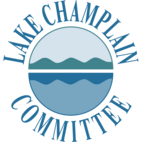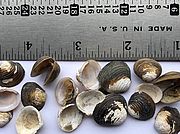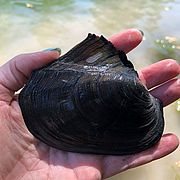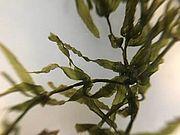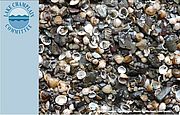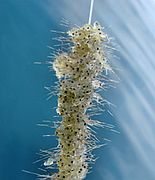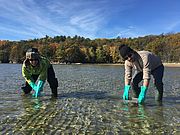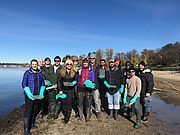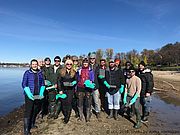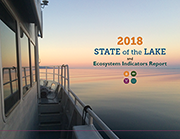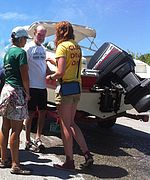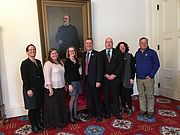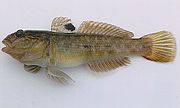Lake Champlain is home to 51 known non-native and aquatic invasive species (AIS), from zebra mussels and alewife to water chestnut and Eurasian watermilfoil, but not yet Asian clam. Invasive species are not native to the Lake Champlain Basin and can compete with native species for space and food, clog water intake pipes, and limit recreational activities. Read...
News from Selected Category
If you’ve paddled, taken a swim, or cast a fishing line in the waterbodies of the Lake Champlain Basin, you’ve likely spent time among one of the most enigmatic groups of aquatic animals in our region: native freshwater mussels. They’re quirky—sporting hatchet-like shells and traveling by a single fleshy foot, yet familiar—related to the invasive zebra mussel and edible bivalves such as littleneck clams and scallops. Read...
In early September, Lake Champlain Basin Program Boat (LCBP) Launch Steward Matthew Gorton was conducting a routine boat inspection for invasive species prevention at a public access site in South Hero, Vermont when he noticed an unusual plant hanging off a boat trailer backing into the lake.
Read...Has the invasive Asian clam made it into Lake Champlain? Join us in our surveying efforts to find out!
We are teaming up with our friends at Arrowwood Environmental and Magic Hat Brewing Company to comb Burlington area beaches for the invasive mollusk. The program includes training, field time, and lunch! It’s a great way to learn more about Asian clams, how to identify them and what we can do to keep them out of Lake Champlain. Read...
A mass die-off has caused many of the invasive alewife fish to wash up at Rossetti park just before New Year. Thousands of the tiny herring coated 100 square feet of the lake’s waterline. According to VT Fish and Wildlife fishery scientist Shawn Good, the die-off is the natural result of the alewife’s sensitivity to fluctuations in temperature. Colchester Sun.
The fishhook waterflea was discovered near Valcour Island in September, making it the fifty-first known invasive species to date in Lake Champlain. The discovery was made by Plattsburgh SUNY’s Lake Champlain Research Institute (LCRI) at an established Lake Champlain Long-term Biological Monitoring Program site supported by the Lake Champlain Basin Program. Analysis of the water samples by LCRI’s Dr. Tim Mihuc and his staff confirmed high densities of over 100 individual fishhook waterfleas per sample.
It was a sunny, crisp October morning. The rainy grey mist from the week before had cleared to reveal a stunning panorama of mountains, lake, and sand. On a beach just north of Burlington LCC staff and volunteers and a crew from Magic Hat Brewery, bundled in warm layers against the morning chill, arranged in a staggered line. Those with muck boots waded through the shallow water, while the others walked along the shoreline. Every few paces each stopped to kneel and scoop up sand in a small metal sieve. They then shook away the sand, as if panning for gold, examined the contents briefly – and discarded them.
For several years, Magic Hat Brewing Company has been funding LCC programs, promoting our work for clean water with special lake brews, and providing volunteer assistance for special projects. Our latest collaboration was a two-day session to search for Asian clams, an invasive mollusk that’s been found in nearby waterways.
It was a sunny, crisp October morning. The rainy grey mist from the week before had cleared to reveal a stunning panorama of mountains, lake, and sand. On a beach just north of Burlington a group of volunteers, bundled in warm layers against the morning chill, were ranged in a staggered line. Those with muck boots waded through the shallow water, while the others walked along the shoreline. Every few paces each stopped to kneel and scoop up sand in a small steel sieve. They then shook away the sand, as if panning for gold, examined the contents briefly – and discarded them.
“This report helps the public to interpret information about the Lake using the best scientific data available. Lake managers use this information to develop and assess strategies for improving water quality in Lake Champlain,” said Dr. Eric Howe, LCBP Director. “In the 2018 report, we provide updated information on the many issues facing Lake Champlain.”
Looking for an outdoor summer job near the water? Enjoy talking to people about the lake? If yes, consider becoming a Lake Champlain boat launch steward. The Lake Champlain Basin Program (LCBP) is hiring up to twelve boat launch stewards to work at New York and Vermont public boat launch access areas during the steward program’s 12th season. The stewards help to reduce the spread of aquatic invasive species by identifying high-risk boats for courtesy inspection and providing information about invasive species spread prevention. Read...
The Lake Champlain Committee (LCC) and environmental consulting firm Arrowwood Environmental (AE) won a competitive grant from the Lake Champlain Basin Program to continue our aquatic invasive species mapping and control project.
Read...The Vermont Citizens Advisory Committee (VT CAC) presented its annual Action Plan to the Vermont Legislature last week in a day-long series of meetings at the Vermont State House.
Read...The spiny waterflea arrived in Lake Champlain last summer, becoming the 50th invasive species in the lake. We know it won’t be the last. Recently, a group of environmental professionals discussed what species posed the greatest risk of being the next arrival. Three likely candidates were round goby, hydrilla, and VHS. Read...
